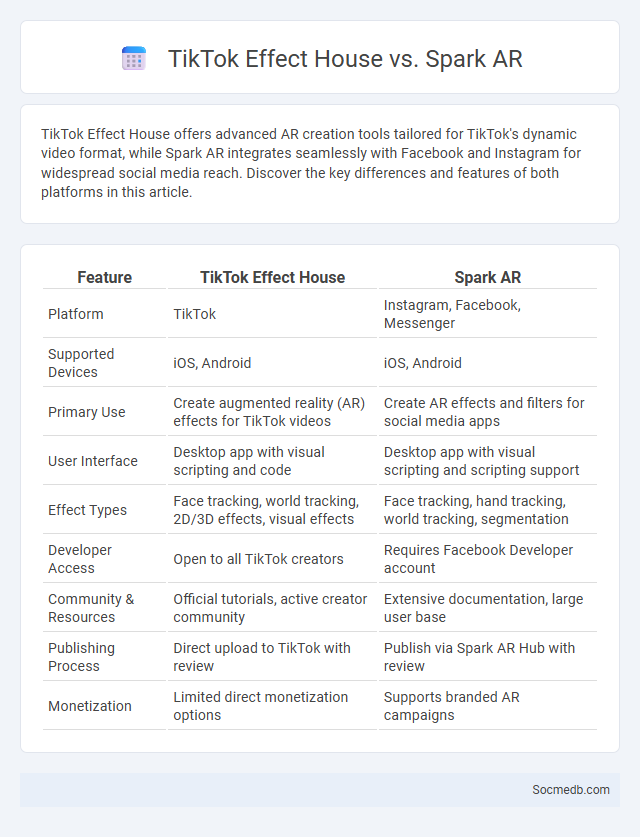
Photo illustration: TikTok Effect House vs Spark AR
TikTok Effect House offers advanced AR creation tools tailored for TikTok's dynamic video format, while Spark AR integrates seamlessly with Facebook and Instagram for widespread social media reach. Discover the key differences and features of both platforms in this article.
Table of Comparison
| Feature | TikTok Effect House | Spark AR |
|---|---|---|
| Platform | TikTok | Instagram, Facebook, Messenger |
| Supported Devices | iOS, Android | iOS, Android |
| Primary Use | Create augmented reality (AR) effects for TikTok videos | Create AR effects and filters for social media apps |
| User Interface | Desktop app with visual scripting and code | Desktop app with visual scripting and scripting support |
| Effect Types | Face tracking, world tracking, 2D/3D effects, visual effects | Face tracking, hand tracking, world tracking, segmentation |
| Developer Access | Open to all TikTok creators | Requires Facebook Developer account |
| Community & Resources | Official tutorials, active creator community | Extensive documentation, large user base |
| Publishing Process | Direct upload to TikTok with review | Publish via Spark AR Hub with review |
| Monetization | Limited direct monetization options | Supports branded AR campaigns |
Introduction to Top AR Platforms
Top AR platforms revolutionize social media by integrating augmented reality experiences directly into content creation and interaction. Platforms like Snapchat's Lens Studio, Facebook's Spark AR, and Instagram's AR effects allow you to seamlessly enhance your posts with immersive visual elements. Leveraging these tools boosts engagement, drives creativity, and transforms how audiences connect with your brand online.
What is TikTok Effect House?
TikTok Effect House is a creative platform developed by TikTok that enables users to design and publish augmented reality (AR) effects for the TikTok app. It provides powerful tools and resources that allow creators to build interactive filters, 3D objects, and dynamic visual experiences to enhance videos and engage audiences. By using TikTok Effect House, you can expand your content's reach and influence through innovative AR effects tailored to TikTok's vibrant community.
Exploring Spark AR: Key Features
Spark AR offers powerful tools for creating augmented reality effects on social media platforms like Instagram and Facebook. Its key features include a user-friendly interface, real-time preview, and extensive asset libraries, enabling creators to design interactive face filters, 3D objects, and environmental effects. Integration with Facebook's ecosystem allows seamless publishing and analytics tracking, enhancing user engagement and campaign effectiveness.
Understanding Effect: An Overview
Social media platforms significantly influence user behavior and perception by shaping the way information is consumed and shared. The Understanding Effect refers to the impact these platforms have on users' cognitive processing, often leading to superficial comprehension due to rapid content exposure. Research highlights that algorithms prioritize engagement over depth, which can affect critical thinking and knowledge retention.
User Interface Comparison
User interface design in social media platforms significantly impacts user engagement and retention, with Facebook emphasizing customizable feeds and extensive privacy settings, while Instagram focuses on visual storytelling through a minimalist and image-centric UI. Twitter's interface prioritizes real-time updates and concise content presentation, enhancing quick information dissemination, whereas TikTok's full-screen video layout supports immersive content consumption and easy navigation via intuitive swipe gestures. These varying UI strategies reflect each platform's core user interaction goals and content delivery methods.
Supported Platforms and Devices
Social media platforms support a wide range of devices including smartphones, tablets, laptops, and desktop computers, ensuring accessibility across iOS, Android, Windows, and macOS operating systems. Leading platforms such as Facebook, Instagram, Twitter, and LinkedIn offer optimized apps and web interfaces designed to deliver seamless user experiences on both mobile and desktop devices. Your ability to connect, share, and engage on social media depends heavily on the compatible platform and device you choose.
Creative Tools and Asset Libraries
Social media platforms offer advanced creative tools such as filters, templates, and editing features that enhance content creation and engagement. Asset libraries provide users with extensive collections of images, videos, and audio resources, streamlining the production of high-quality posts. These resources boost brand visibility and enable consistent, visually appealing storytelling across multiple channels.
Community and Marketplace Support
Social media platforms create vibrant communities that foster engagement and shared interests, enabling you to connect with like-minded individuals globally. These platforms also support marketplace functions by facilitating direct transactions, customer reviews, and targeted advertising to enhance business reach. Robust community and marketplace features empower users and brands to build trust and drive economic growth efficiently.
Monetization and Brand Opportunities
Social media platforms offer powerful monetization options such as sponsored content, affiliate marketing, and direct product sales, enabling creators and businesses to generate substantial revenue. Leveraging targeted ad campaigns and influencer collaborations enhances brand visibility and drives customer engagement across diverse demographics. Your strategic use of these opportunities can transform online presence into a profitable brand asset with measurable growth outcomes.
Which AR Platform is Best for You?
Choosing the best AR platform depends on your specific social media goals and target audience. Platforms like Snapchat's Lens Studio excel in interactive filters, while Instagram Spark AR offers seamless integration with Facebook's extensive user base, enhancing your content reach and engagement. Understanding your content style and audience preferences will help you select the AR tool that maximizes your social media impact.
 socmedb.com
socmedb.com